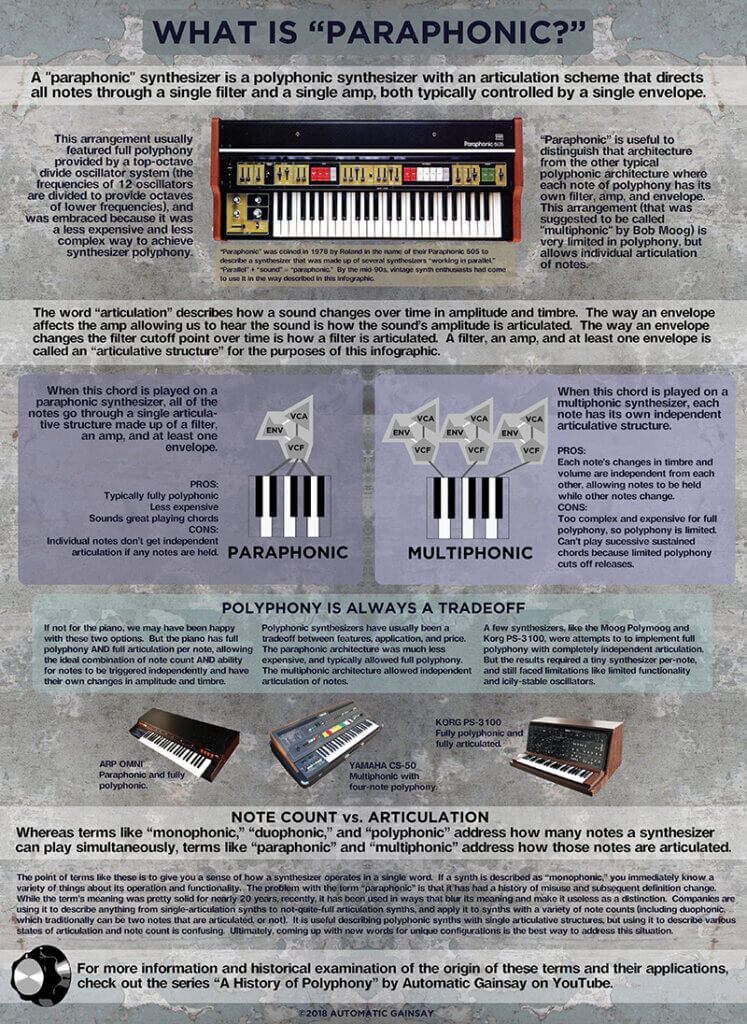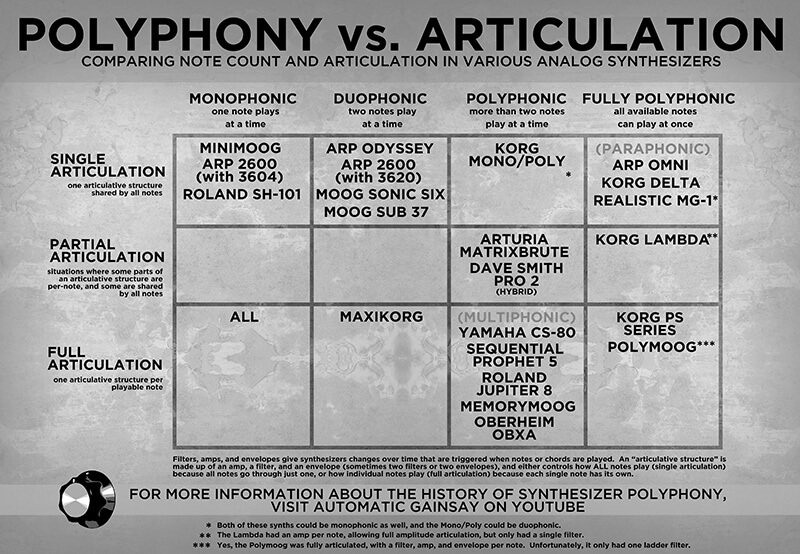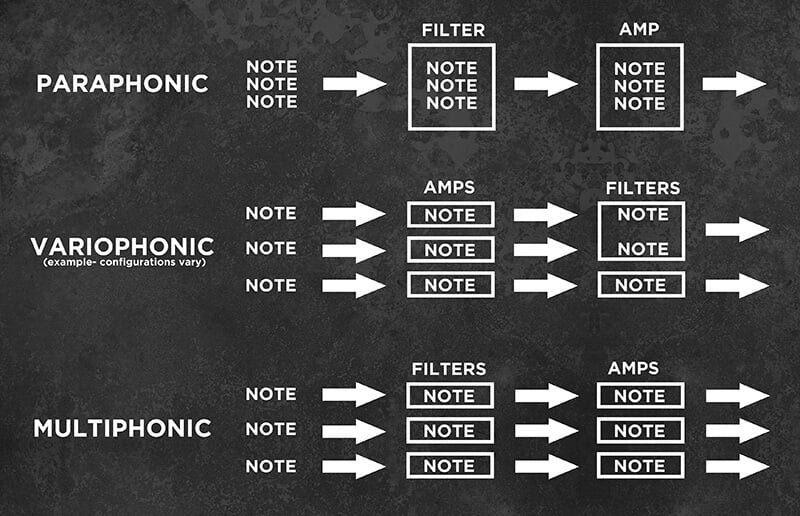Synthesizer Polyphony Terminology and the Polyphonic vs. Paraphonic Debate
Talking about, or learning about, synthesizers can be a challenge in general, but the situation is made worse by the fact that synthesizer culture lacks firm, codified terminology. Whether it’s because of the strange, immediate, and recent history of the synthesizer, or the way that social media corrupts terminology, it’s not always exactly clear what the terms thrown around in regard to synthesizers specifically mean.
Take, for example, the terms associated with how many notes a synthesizer can play at once. There is a tremendous amount of confusion about how to use these terms, and what they mean. This confusion is further complicated by companies who are using them in various, self-serving, and different ways.
Here is a short exploration of the terms associated with synthesizer note count… polyphony, monophony, duophony, and paraphony… and the history of how they came to be used.

Traditionally, keyboard-based instruments like the piano played a note per key, and each of these notes had their own natural independent progression of timbral and amplitude change as the note played, irrespective of what was happening with other notes played. These changes were natural to the design and can be described using the term “articulation.” Culturally, we’re very accustomed to this behavior from traditional keyboard instruments and have some expectation that all instruments with keyboards are going to behave in this way. But with synthesizers, we may not want to make that assumption.
There were many keyboard-controlled electronic instruments created between 1897 and 1964. In each of them, there was always the challenge of note count and articulation. Myriad concessions were made due to the fact that technological limitations and great expense were inherent in the process.
Bob Moog ran into these challenges as he was initially envisioning the groundbreaking transistorized voltage-controlled modular electronic studio he was creating for Herb Deutsch. For the instrument to play more than one articulated note at a time, he would need to have a full synthesizer available per note. In addition to that, his keyboard controller would have to have some means of allocating each note played to an individual synthesizer signal chain. Trying to solve this technological puzzle took away from the thrill of creating an electronic music studio instrument, so he designed the instrument to play one note at a time per keyboard controller. Synthesis was more important than note count and articulation to him at that point.

When typical musicians played Bob’s keyboard-controlled instrument, they often tried to play more than one note at a time, expecting that it would work like a piano or organ. But, it didn’t. It was necessary to coin the term “monophonic (one note)” in the synthesizer industry so that there wasn’t confusion about this implementation of the keyboard.
The fact that musicians wanted to be able to play multiple synthesizer notes simultaneously inspired the coinage of another synthesizer term: “polyphonic (many notes).” It was the envisioning of a synthesizer that could play multiple (and hopefully articulated) notes simultaneously.
In 1969, a clever keyboard design allowed for the sensing of two different note voltages. These voltages could be applied to two different oscillators, allowing two frequencies (single articulation) to be played simultaneously from the keyboard. The outcome came to be described as “duophonic (two notes).” The ARP Odyssey was one of the first to feature this function.
Synthesizer companies recognized performing musicians’ desire for a polyphonic product in the early 70s, and a sort of race to create one began.
An engineer named Dave Luce was hired at Moog Music in 1973 to try his hand at creating an affordable polyphonic synthesizer for the company. He used an old polyphony trick that required only 12 oscillators (The trick is one where the oscillators of the top octave are divided to provide the notes for the subsequent octaves.), and directed them through a single filter, amp, and envelope (called an “articulative structure”). So, playing chords sounded great, but it didn’t play like a piano if you played chords, passing notes, melodies, etc. together. Still, it was useful. This creation was called the “Moog Apollo,” but Moog wasn’t happy with it, and it didn’t become a product. However, ARP created a similar keyboard concept in the ARP Omni, and it became one of the best-selling synthesizers of the 1970s.
Dave Rossum of E-mu came up with a way to digitally scan a keyboard, allowing the ability to assign different notes to oscillators and different note events to envelopes, making it so that synthesizers could create multiple note events with independent filter and amp articulations.
Companies took the digital-scanning keyboard concept and applied it to a new polyphonic synthesizer concept. Instead of having full polyphony directed through a single filter, amp, and envelope, they took a limited number of oscillators and directed them through the same amount of filters, amps, and envelopes. While the polyphony was comparatively very limited, it allowed each note to have its own articulation, and the digital scanning keyboard made it possible. Musicians seemed more willing to take very limited polyphony with full articulation than to take full polyphony with limited articulation. Bob Moog suggested that this architecture wasn’t full polyphony due to the limited note count, and that it should have a different name… perhaps something like “multiphonic.”

As components became less expensive, a couple of companies did put full polyphony through full articulation, which essentially required a synthesizer-per-key. But this architecture was never given a name, likely due to the fact that it was uncommon. The Polymoog, often considered “the first modern polyphonic synthesizer,” went this route with some success.
These types of polyphonic synthesizers defined how note count and articulation was implemented for a number of years. As digital synthesizers became more prevalent, it became easier to design fully-polyphonic synthesizers with full articulation per note of polyphony. Terms related to polyphonic architecture stopped being necessary.
But analog polyphonic architecture made a reappearance in the 2010s, and suddenly, there is the need for terms for these different configurations, again. Unfortunately, time, user misuse, marketing misuse, and general confusion has blurred some of the meaning.
But what does “paraphonic” mean? In the late 1970s, companies were making all-purpose polyphonic performance synthesizers that allowed live musicians to have a string sound, an organ sound, a monophonic synthesizer, etc. Roland made one of these multiple-synths-stacked-together instruments called the “Paraphonic 505.” The term was coined to mean the equivalent of “parallel sound.” In the mid 1990s, synthesizer players started to miss analog synthesizers. A fanship of them arose, and those interested would get together on Internet usergroups and talk about them. At some point, Roland’s marketing term “paraphonic” was misused and came to be used to describe top-octave-divide polyphonic synths with a single articulative structure. This was kind of a good thing, as this term came to describe a whole category of polyphonic synths that came out in the 1970s, like the ARP Omni.
Several companies have tried to change the definition of the term again, as a term that just indicates “limited articulation polyphony,” but examples of this careless misapplication have led users to think that paraphony, an articulation paradigm, is different from polyphony, a note count number. This is why clarification of these terms and their history helps.
Today, synthesizer fans are interested in the vintage synths of the past, the modern reproductions of classic synths from the past, and modern analog synths that have the structural designs that require the terminology we’ve been discussing. Since some of this history is 50 years in the past, or more, it’s important to preserve useful terminology in order to accurately and effectively describe the instruments we use. So, here are terms related to synthesizer polyphony and synthesizer polyphonic articulation that are useful in the categorization of polyphonic instruments:
GLOSSARY OF USEFUL TERMS
Polyphonic/Polyphony: Capable of producing multiple notes simultaneously when played.
Monophonic/Monophony: Capable of producing one single (usually articulated) note at a time when played. Example: Moog Minimoog
Duophonic/Duophony: Capable of producing two notes (unarticulated or articulated) at a time when played. Example: ARP Odyssey
Paraphonic: Multiple notes, often full polyphony, directed through a single articulative structure. Example: ARP Omni
Multiphonic: Limited note count (4, 6, or 8, usually) where each note is fully articulated with its own filter, amp, and at least one envelope. Example: Yamaha CS-80
Variophonic: Proposed term to describe polyphony with more than one articulation structure, but less articulation than the full note count. Example: Arturia MatrixBrute
ABOUT THE AUTHOR
Marc Doty is a composer, synthesist, and educator responsible for the popular analog synth demonstration YouTube channel, Automatic Gainsay.
